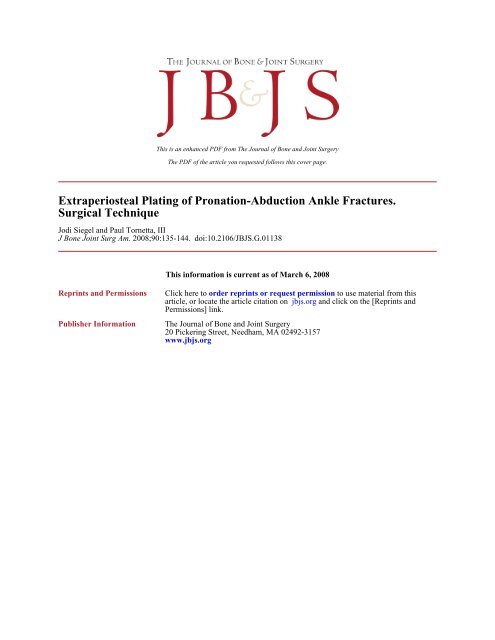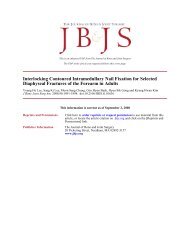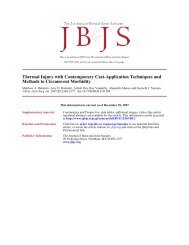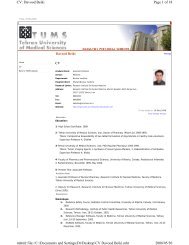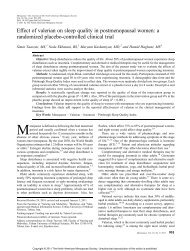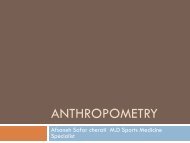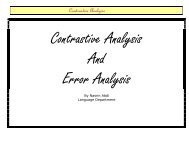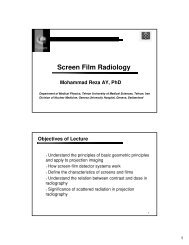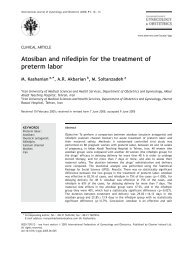Extraperiosteal Plating of Pronation-Abduction Ankle Fractures
Extraperiosteal Plating of Pronation-Abduction Ankle Fractures
Extraperiosteal Plating of Pronation-Abduction Ankle Fractures
Create successful ePaper yourself
Turn your PDF publications into a flip-book with our unique Google optimized e-Paper software.
This is an enhanced PDF from The Journal <strong>of</strong> Bone and Joint Surgery<br />
The PDF <strong>of</strong> the article you requested follows this cover page.<br />
<strong>Extraperiosteal</strong> <strong>Plating</strong> <strong>of</strong> <strong>Pronation</strong>-<strong>Abduction</strong> <strong>Ankle</strong> <strong>Fractures</strong>.<br />
Surgical Technique<br />
Jodi Siegel and Paul Tornetta, III<br />
J Bone Joint Surg Am. 2008;90:135-144. doi:10.2106/JBJS.G.01138<br />
Reprints and Permissions<br />
Publisher Information<br />
This information is current as <strong>of</strong> March 6, 2008<br />
Click here to order reprints or request permission to use material from this<br />
article, or locate the article citation on jbjs.org and click on the [Reprints and<br />
Permissions] link.<br />
The Journal <strong>of</strong> Bone and Joint Surgery<br />
20 Pickering Street, Needham, MA 02492-3157<br />
www.jbjs.org
135<br />
COPYRIGHT © 2008 BY THE JOURNAL OF BONE AND JOINT SURGERY, INCORPORATED<br />
<strong>Extraperiosteal</strong> <strong>Plating</strong> <strong>of</strong> <strong>Pronation</strong>-<br />
<strong>Abduction</strong> <strong>Ankle</strong> <strong>Fractures</strong><br />
Surgical Technique<br />
By Jodi Siegel, MD, and Paul Tornetta III, MD<br />
Investigation performed at the Department <strong>of</strong> Orthopaedic Surgery, Boston University Medical Center, Boston, Massachusetts<br />
The original scientific article in which the surgical technique was presented was published in JBJS Vol. 89-A, pp. 276-81, February 2007<br />
ABSTRACT FROM THE ORIGINAL ARTICLE<br />
BACKGROUND: <strong>Pronation</strong>-abduction ankle fractures frequently are associated with substantial lateral comminution and<br />
have been reported to be associated with the highest rates <strong>of</strong> nonunion among indirect ankle fractures. The purpose <strong>of</strong><br />
the present study was to report the technique for and outcomes <strong>of</strong> extraperiosteal plating in a series <strong>of</strong> patients with<br />
pronation-abduction ankle fractures.<br />
METHODS: Thirty-one consecutive patients with an unstable comminuted pronation-abduction ankle fracture were managed<br />
with extraperiosteal plating <strong>of</strong> the fibular fracture. The average age <strong>of</strong> the patients was forty-four years. There were nineteen<br />
bimalleolar and twelve lateral malleolar fractures with an associated deltoid ligament injury. No attempt to reduce<br />
the comminuted fragments was made as this area was spanned by the plate. The patients were evaluated functionally<br />
(with use <strong>of</strong> the American Orthopaedic Foot and <strong>Ankle</strong> Society score), radiographically, and clinically (with range-<strong>of</strong>-motion<br />
testing).<br />
RESULTS: Immediate postoperative and final follow-up radiographs showed that all patients had a well-aligned ankle mortise<br />
on the fractured side as compared with the normal side on the basis <strong>of</strong> standardized measurements. All fractures<br />
healed without displacement. At a minimum <strong>of</strong> two years after the injury, the average American Orthopaedic Foot and <strong>Ankle</strong><br />
Society score (available for twenty-one patients) was 82. The range <strong>of</strong> motion averaged 13° <strong>of</strong> dorsiflexion and 31° <strong>of</strong><br />
plantar flexion, with one patient not achieving dorsiflexion to neutral. There were no deep infections, and one patient had<br />
an area <strong>of</strong> superficial skin breakdown that healed without operative intervention.<br />
CONCLUSIONS: <strong>Extraperiosteal</strong> plating <strong>of</strong> pronation-abduction ankle fractures is an effective method <strong>of</strong> stabilization that<br />
leads to predictable union <strong>of</strong> the fibular fracture. The results <strong>of</strong> this procedure are at least as good as those <strong>of</strong> other<br />
techniques <strong>of</strong> open reduction and internal fixation <strong>of</strong> the ankle, although specific results for pronation-abduction injuries<br />
have not been previously reported, to our knowledge.<br />
LEVEL OF EVIDENCE: Therapeutic Level IV. See Instructions to Authors for a complete description <strong>of</strong> levels <strong>of</strong> evidence.<br />
ORIGINAL ABSTRACT CITATION:“<strong>Extraperiosteal</strong> <strong>Plating</strong> <strong>of</strong> <strong>Pronation</strong>-<strong>Abduction</strong> <strong>Ankle</strong> <strong>Fractures</strong>” (2007;89:276-81).<br />
DISCLOSURE: The authors did not receive any outside funding or grants in support <strong>of</strong> their research for or preparation <strong>of</strong> this work. Neither they nor a member <strong>of</strong><br />
their immediate families received payments or other benefits or a commitment or agreement to provide such benefits from a commercial entity. No commercial<br />
entity paid or directed, or agreed to pay or direct, any benefits to any research fund, foundation, division, center, clinical practice, or other charitable or nonpr<strong>of</strong>it<br />
organization with which the authors, or a member <strong>of</strong> their immediate families, are affiliated or associated.<br />
A video supplement to this article developed by the American Academy <strong>of</strong> Orthopaedic Surgeons and JBJS is available at the JBJS web site, www.jbjs.org.<br />
To obtain a copy <strong>of</strong> the video, contact the AAOS at 800-626-6726 or go to their web site, www.aaos.org, and click on Educational Resources Catalog<br />
J Bone Joint Surg Am. 2008;90 Suppl 2 (Part 1):135-44 • doi:10.2106/JBJS.G.01138
136<br />
T HE JOURNAL OF BONE & JOINT SURGERY · SURGICAL TECHNIQUES MARCH 2008 · VOLUME 90-A · SUPPLEMENT 2, PART 1 · JBJS.ORG<br />
INTRODUCTION<br />
The Lauge-Hansen ankle fracture<br />
classification system correlates<br />
the radiographic features <strong>of</strong><br />
a fracture with the mechanism<br />
<strong>of</strong> injury, defining which forces<br />
to counter in order to reduce<br />
and surgically stabilize a<br />
fracture 1 . The deforming force<br />
in pronation-abduction fractures<br />
is translational rather than<br />
rotational, with the medial<br />
structures failing first, under<br />
tension, and the fibula fracturing<br />
last. This typically results in<br />
FIG. 1<br />
a transverse fracture line approximately<br />
5 cm proximal to<br />
the joint with lateral comminution,<br />
consistent with bending<br />
failure (Fig. 1). With the use <strong>of</strong><br />
an extraperiosteal approach, the<br />
s<strong>of</strong>t-tissue attachments to the<br />
fracture fragments are preserved,<br />
which maintains blood<br />
flow to promote healing and aids<br />
in obtaining the reduction.<br />
SURGICAL TECHNIQUE<br />
The patient is placed supine on a<br />
standard operating-room table,<br />
with a small bump under the ipsilateral<br />
hip so the knee is<br />
straight up and down. No tourniquet<br />
is utilized. If the ankle<br />
fracture is bimalleolar and the<br />
medial malleolar fracture pattern<br />
is supracollicular, it is reduced<br />
and fixed as the first step<br />
in the procedure. This aids in<br />
the reduction because the deep<br />
deltoid ligament, the strongest<br />
portion <strong>of</strong> the ligament, which<br />
attaches to the posterior colliculus<br />
and the intercollicular<br />
groove, is attached to the dis-<br />
A bimalleolar stage-3 pronation-abduction ankle fracture showing lateral comminution with bending failure <strong>of</strong> the fibula after an abduction<br />
stress.
137<br />
T HE JOURNAL OF BONE & JOINT SURGERY · SURGICAL TECHNIQUES MARCH 2008 · VOLUME 90-A · SUPPLEMENT 2, PART 1 · JBJS.ORG<br />
placed medial malleolar<br />
fragment 2 . Thus, an anatomic reduction<br />
<strong>of</strong> a supracollicular medial<br />
malleolar fracture restores<br />
medial support, gains talar congruence,<br />
and assists with reduction<br />
<strong>of</strong> the lateral malleolus 2,3<br />
(Fig. 2-A). The incision used on<br />
the medial side is slightly concave<br />
anteriorly and is centered over<br />
the medial malleolus, as this allows<br />
both visualization <strong>of</strong> the reduction<br />
and placement <strong>of</strong> the<br />
screws (Fig. 2-B). Bicortical lagscrew<br />
fixation, perpendicular to<br />
the fracture line, is preferred to<br />
increase the stability <strong>of</strong> the fixation<br />
and to compress across the<br />
fracture site (Fig. 3).<br />
Attention is then turned to<br />
the lateral side. The ankle should<br />
be positioned with bolsters under<br />
the ankle joint and not under<br />
the heel. Bolsters under the heel<br />
can cause anterior subluxation <strong>of</strong><br />
the talus and a malreduction.<br />
The foot is adducted and medially<br />
translated to center the talus<br />
in the mortise, which aids in fibular<br />
alignment. Because the lateral<br />
ankle ligaments are intact in<br />
this injury pattern, reducing the<br />
talus under the plafond usually<br />
aligns the distal fibular fragment<br />
and restores fibular length. Fluoroscopic<br />
imaging at this point allows<br />
an assessment <strong>of</strong> fibular<br />
length. The lateral cortex <strong>of</strong> the<br />
fibula is comminuted, but the<br />
medial cortex typically starts as a<br />
transverse fracture line, so one<br />
can evaluate the reduction at this<br />
location to assess length (Fig. 4).<br />
Finally the talocrural angle on<br />
the affected side is compared<br />
with the contralateral, normal<br />
ankle to confirm fibular length 4 .<br />
As the talocrural angle is not related<br />
to the size <strong>of</strong> an image, fluoroscopic<br />
evaluation is not<br />
affected by magnification, as are<br />
other measures <strong>of</strong> fibular length.<br />
After determining the necessary<br />
manipulation <strong>of</strong> the foot that<br />
recreates fibular length, one can<br />
proceed. (For additional techniques<br />
to gain fibular length, see<br />
separate section below.)<br />
Once the general reduction<br />
<strong>of</strong> the fibula can be obtained, the<br />
incision is made. The incision is<br />
centered over the posterior onehalf<br />
<strong>of</strong> the fibula. When the incision<br />
has been made through the<br />
skin, care is taken not to incise<br />
the periosteum. It is found immediately<br />
subcutaneously and<br />
<strong>of</strong>ten has small rents in it as part<br />
<strong>of</strong> the injury, which can make it<br />
difficult to recognize. Sharp<br />
Weitlaner retractors can aid by<br />
applying tension to the skin,<br />
helping to peel the subcutaneous<br />
tissues from the periosteum. The<br />
periosteum is left entirely intact;<br />
individual fracture fragments are<br />
not identified, stripped, or further<br />
handled. Once the dissection<br />
is at the level <strong>of</strong> the<br />
periosteum (Fig. 5), all retractors<br />
are removed from the<br />
wound as they can shorten the<br />
fibula because <strong>of</strong> the tension<br />
placed on the surrounding s<strong>of</strong>t<br />
tissues. Reduction is obtained by<br />
manipulating the foot, and then<br />
a lateral fluoroscopic image is<br />
made to confirm that there is no<br />
angulation or translation <strong>of</strong> the<br />
fibula. This is the last time that<br />
an unobstructed lateral radiograph<br />
can be made so it is imper-<br />
ative that any sagittal plane<br />
displacement <strong>of</strong> the fibula is corrected<br />
now. Once this is completed,<br />
the anteroposterior<br />
radiograph is made again to confirm<br />
the coronal plane reduction.<br />
Residual lateral translation or<br />
angulation is <strong>of</strong>ten seen; this is<br />
normal and is corrected later<br />
with the undercontoured plate.<br />
Next, a precontoured<br />
direct lateral fibular plate, or a<br />
straight one-third tubular smallfragment<br />
plate that the surgeon<br />
contours to the shape <strong>of</strong> the distal<br />
aspect <strong>of</strong> the fibula, is placed<br />
into the wound. It is vital that the<br />
plate be slightly undercontoured<br />
in relation to the lateral surface<br />
<strong>of</strong> the fibula as this ultimately<br />
corrects the lateral translation <strong>of</strong><br />
the fibula. The plate is placed<br />
onto the fibula, with the surgeon<br />
ensuring that it is centered between<br />
the anterior and posterior<br />
borders <strong>of</strong> the bone. This is done<br />
initially by feel as one cannot<br />
strip the s<strong>of</strong>t tissue from the fibula<br />
to visualize the bone directly,<br />
but a Kirschner wire can be used<br />
as a probe to assist in identifying<br />
the anterior and posterior borders<br />
<strong>of</strong> the fibula. Fluoroscopic<br />
lateral imaging is required to<br />
confirm that the plate is centered<br />
on the bone before fixation<br />
is placed (Fig. 6-A). This is paramount<br />
for the reduction as the<br />
direction <strong>of</strong> the force provided<br />
by the plate must be directly medially<br />
to reduce the laterally<br />
translated fibula. Additionally,<br />
the fibula must be evaluated for<br />
angulation. Any anterior or posterior<br />
angulation must be corrected<br />
prior to fixation by
138<br />
T HE JOURNAL OF BONE & JOINT SURGERY · SURGICAL TECHNIQUES MARCH 2008 · VOLUME 90-A · SUPPLEMENT 2, PART 1 · JBJS.ORG<br />
FIG. 2-A<br />
The medial malleolus is composed <strong>of</strong> the anterior and posterior colliculi. A supracollicular fracture (left) extends from the anterior tibial cortex<br />
to the posterior tibial cortex; an anterior collicular fracture (right) exits inferiorly between the colliculi, creating an anterior fracture fragment.<br />
The broad superficial deltoid ligament, which is the weaker <strong>of</strong> the two portions <strong>of</strong> the ligament, takes its origin from the anterior<br />
colliculus and acts to prevent external rotation <strong>of</strong> the ankle when the foot is in plantar flexion. The stronger deep deltoid ligament originates<br />
from the posterior colliculus and the intercollicular groove, and prevents external rotation <strong>of</strong> the ankle with the foot in dorsiflexion. Fixation <strong>of</strong><br />
a supracollicular medial malleolar fracture, with the deltoid ligament (most importantly, the deep portion) intact on it, restores medial<br />
stability 3 . The incision is concave anteriorly, which allows visualization <strong>of</strong> the joint and placement <strong>of</strong> lag screws perpendicular to the fracture.<br />
moving the bolster to an appropriate<br />
position. Once appropriate<br />
plate position is confirmed,<br />
the plate is provisionally fixed to<br />
the bone with Kirschner wires or<br />
provisional fixation pins (Fig. 6-<br />
B). After temporary fixation, the<br />
centered location <strong>of</strong> the plate on<br />
the fibula is again confirmed.<br />
Screws can then be placed, from<br />
proximal to distal, which will<br />
push the fibula (and therefore<br />
the talus) medially, under the<br />
plafond (Figs. 7-A and 7-B). The<br />
reduction is confirmed on the<br />
anteroposterior radiograph. If<br />
the talus does not reduce, one <strong>of</strong><br />
two problems exists. Either the<br />
syndesmosis is unreduced or the<br />
plate is incorrectly contoured to<br />
effect a reduction and the fibula
139<br />
T HE JOURNAL OF BONE & JOINT SURGERY · SURGICAL TECHNIQUES MARCH 2008 · VOLUME 90-A · SUPPLEMENT 2, PART 1 · JBJS.ORG<br />
FIG. 2-B<br />
Incision and dissection for medial malleolar fixation. The fracture is now reduced and<br />
clamped with a bone tenaculum. Note the visualization <strong>of</strong> the joint while the surgeon is<br />
still able to place lag screws perpendicular to the fracture.<br />
is not anatomic. If the fibula is<br />
not accurately reduced, then the<br />
plate must be removed, recon-<br />
FIG. 3<br />
Medial malleolar fixation with bicortical lag screws<br />
ideally placed parallel to each other and perpendicular<br />
to the fracture site. Since the tibia is a curved<br />
bone, the screws may appear as though they are<br />
not bicortical when in fact they are penetrating the<br />
posterior cortex. Bicortical screws increase stability<br />
and allow compression across the fracture site.<br />
toured, and replaced, with attention<br />
to fibular length. If the<br />
fibula is anatomically aligned,<br />
then the syndesmosis is unstable<br />
and needs to be reduced and stabilized<br />
as described below.<br />
With both medial and lateral<br />
stability restored, the syndesmosis<br />
must be tested for stability.<br />
If the medial injury is ligamentous,<br />
the syndesmosis is tested by<br />
applying an abduction stress on<br />
the foot and evaluating the medial<br />
clear space, the syndesmotic<br />
space, and residual talar subluxation<br />
(Fig. 8-A). If the medial injury<br />
is osseous and fixation is in<br />
place, then a clamp is placed on<br />
the fibula and an abduction stress<br />
is applied. If >2 mm <strong>of</strong> lateral<br />
translation occurs at the syndesmotic<br />
notch, syndesmotic fixation<br />
is indicated. The reduction<br />
<strong>of</strong> the syndesmosis can be accomplished<br />
in several ways. Most<br />
commonly, we use a large balltipped<br />
reduction clamp, which<br />
engages a plate hole or screw
140<br />
T HE JOURNAL OF BONE & JOINT SURGERY · SURGICAL TECHNIQUES MARCH 2008 · VOLUME 90-A · SUPPLEMENT 2, PART 1 · JBJS.ORG<br />
FIG. 4<br />
Intraoperative fluoroscopic image made after preliminary closed reduction. The fibula is<br />
out to length as determined by the alignment <strong>of</strong> the fracture line at the medial cortex.<br />
head on the fibula and the anteromedial<br />
distal aspect <strong>of</strong> the tibia.<br />
It does not require much force to<br />
accurately reduce the syndesmosis,<br />
but tightening the clamp too<br />
hard can translate the fibula posteriorly.<br />
A perfect lateral radiograph<br />
to confirm the fibular<br />
location and compare it with the<br />
normal ankle prevents malreduction<br />
as there is no direct visualization<br />
<strong>of</strong> this region. Alternately,<br />
direct digital pressure by the surgeon<br />
can be used to hold the reduction.<br />
In rare cases, the<br />
syndesmotic screw can be placed<br />
as a lag screw to obtain the reduction,<br />
but it must be placed<br />
through the plate exactly in the<br />
plane perpendicular to the tibi<strong>of</strong>ibular<br />
axis and care must be<br />
taken not to overtighten it as this<br />
will overcontour the plate<br />
through the area <strong>of</strong> fibular comminution.<br />
Once the reduction is<br />
achieved and is confirmed on the<br />
anteroposterior and lateral radiographs,<br />
the syndesmotic screws<br />
are placed through the plate,<br />
which acts as a substitute for the<br />
lateral cortex (Fig. 8-B). Typically,<br />
syndesmotic fixation is<br />
FIG. 5<br />
achieved with one or two fully<br />
threaded 3.5-mm cortical position<br />
screws (non-lag), placed just<br />
proximal to the subchondral<br />
bone <strong>of</strong> the plafond, through the<br />
plate, and through three cortices.<br />
When there is substantial comminution<br />
in the fibula, screws can<br />
be placed through the plate and<br />
into the tibia to gain additional<br />
fixation even if the syndesmosis is<br />
stable with a stress examination.<br />
This is recommended if more<br />
than two screw holes in the plate<br />
are not usable because <strong>of</strong> fibular<br />
comminution.<br />
Fibular Length<br />
Restoring fibular length is one <strong>of</strong><br />
the most important aspects <strong>of</strong><br />
this technique. In general, it is<br />
not difficult to restore length because<br />
<strong>of</strong> the pure bending mechanism<br />
<strong>of</strong> the injury. Occasionally,<br />
however, restoring and confirming<br />
fibular length with use <strong>of</strong> the<br />
Intraoperative example <strong>of</strong> extraperiosteal dissection. The peroneal tendons are visible.<br />
The outline <strong>of</strong> the fibula has been drawn in. There is a rent in the periosteum caused by<br />
the initial fracture displacement (red arrow). Weitlaner retractors help to identify the<br />
plane between the subcutaneous tissues and the periosteum.
141<br />
T HE JOURNAL OF BONE & JOINT SURGERY · SURGICAL TECHNIQUES MARCH 2008 · VOLUME 90-A · SUPPLEMENT 2, PART 1 · JBJS.ORG<br />
FIG. 6-A<br />
The lateral fluoroscopic image demonstrating that there is no translation and no angulation and that the plate is centered over the fibula.<br />
FIG. 6-B<br />
Anteroposterior fluoroscopic image after provisional fixation <strong>of</strong> the plate, showing reduction.<br />
previously described methods<br />
can be challenging. Close attention<br />
to the reduction <strong>of</strong> the uncomminuted<br />
medial cortex <strong>of</strong><br />
the fibula and use <strong>of</strong> the talocrural<br />
angle 4 are the best ways to<br />
judge length (Fig. 9). If length is<br />
not restored with the previously<br />
described technique, one can try<br />
grasping the distal end <strong>of</strong> the fibula<br />
with a bone tenaculum and<br />
applying straight distal traction.<br />
Sometimes, the restored length<br />
can be held with a Kirschner wire<br />
driven into the tibia; alternatively,<br />
one must maintain the<br />
length manually while inserting<br />
the proximal screws into the
142<br />
T HE JOURNAL OF BONE & JOINT SURGERY · SURGICAL TECHNIQUES MARCH 2008 · VOLUME 90-A · SUPPLEMENT 2, PART 1 · JBJS.ORG<br />
FIG. 7-A FIG. 7-B<br />
Fig. 7-A There is mild residual lateral fracture displacement and joint subluxation. Fig. 7-B With the plate used as a reduction tool, both the<br />
fracture and the talus have been reduced to their anatomic position.<br />
FIG. 8-A FIG. 8-B<br />
Fig. 8-A After lateral fixation is complete, the syndesmosis is stressed. Note that the medial clear space and syndesmotic space are widened<br />
while the fibula remains anatomically aligned, indicating syndesmotic instability. Medial clear space widening (arrow) can be appreciated.<br />
Fig. 8-B The syndesmosis is reduced, and a syndesmotic screw is placed. Additionally, with this fixation, the plate is acting as a<br />
substitute lateral cortex.
143<br />
T HE JOURNAL OF BONE & JOINT SURGERY · SURGICAL TECHNIQUES MARCH 2008 · VOLUME 90-A · SUPPLEMENT 2, PART 1 · JBJS.ORG<br />
FIG. 9<br />
The talocrural angle after indirect reduction <strong>of</strong> the affected side (left) is within 1° <strong>of</strong> the normal side (right), providing an objective measure<br />
<strong>of</strong> fibular length and congruence <strong>of</strong> the mortise 4 .<br />
plate. If fibular length is restored<br />
with this technique, screws must<br />
be placed into the distal fragment<br />
or length will be lost once the<br />
Kirschner wire (or manual traction)<br />
is removed.<br />
If fibular length cannot be<br />
restored with use <strong>of</strong> this method,<br />
then the last option is to fix the<br />
plate to the distal fragment <strong>of</strong> the<br />
fibula and use an articulated<br />
compression-distraction device<br />
proximally to push the fibula out<br />
to length. When this is done, a<br />
clamp must be used to hold the<br />
plate to the bone proximally or<br />
the tensioning device will lift it<br />
<strong>of</strong>f the bone. Once length is restored<br />
in this way, the proximal<br />
screws can be inserted in the<br />
plate. The downside to this technique<br />
is the additional exposure<br />
required to use the articulated<br />
compression-distraction device.<br />
However, without restoration <strong>of</strong><br />
fibular length, proper ankle mechanics<br />
will not be reestablished.<br />
Care should be taken to maintain<br />
as much s<strong>of</strong>t-tissue integrity <strong>of</strong><br />
the fracture fragments as possible<br />
to preserve healing potential.<br />
This outrigger method is simple<br />
and predictable but is rarely<br />
needed.<br />
POSTOPERATIVE MANAGEMENT<br />
Postoperatively, patients who<br />
have a stable syndesmosis are<br />
kept non-weight-bearing for six<br />
weeks, but, in compliant pa-<br />
tients, active and passive motion<br />
is permitted as soon as the<br />
wounds are healed. If syndesmotic<br />
screws are required,<br />
weight-bearing is deferred for<br />
twelve weeks. Active and passive<br />
motion is begun at four weeks in<br />
compliant patients. After twelve<br />
weeks, patients are <strong>of</strong>fered syndesmotic<br />
screw removal. If the<br />
patient chooses to have the hardware<br />
removed, it is removed<br />
prior to the commencement <strong>of</strong><br />
any weight-bearing. If the patient<br />
elects not to have the screw removed,<br />
he or she is told that the<br />
screw(s) will either loosen or<br />
break at some point in the future<br />
and the patient is unlikely to<br />
know when that happens.
144<br />
T HE JOURNAL OF BONE & JOINT SURGERY · SURGICAL TECHNIQUES MARCH 2008 · VOLUME 90-A · SUPPLEMENT 2, PART 1 · JBJS.ORG<br />
CRITICAL CONCEPTS<br />
INDICATIONS:<br />
<strong>Ankle</strong> fractures caused by a lateral bending force (Lauge-Hansen pronation-abduction ankle fractures)<br />
CONTRAINDICATIONS:<br />
<strong>Ankle</strong> fractures caused by rotational or medial bending forces (Lauge-Hansen supination-external rotation, pronation-external<br />
rotation, or supination-adduction ankle fractures)<br />
Substantial lateral s<strong>of</strong>t-tissue injury causing blisters, unresolved swelling, or other open wounds<br />
PITFALLS:<br />
Not correctly evaluating or restoring fibular length<br />
Not placing the plate directly laterally, thereby creating an inappropriate vector with the plate, which will not counter the<br />
deforming forces on the ankle<br />
Placing the bolster under the heel, which can cause anterior talar subluxation and ankle malreduction<br />
Aggressive dissection, thereby stripping the periosteum. This violates the blood supply, increases the risk for nonunion,<br />
and destroys the ability to use s<strong>of</strong>t-tissue tension to generally align the fragments.<br />
Not obtaining a perfect reduction on the lateral radiograph<br />
AUTHOR UPDATE:<br />
No changes have occurred in the surgical technique since the original article was published.<br />
Jodi Siegel, MD<br />
Paul Tornetta III, MD<br />
Department <strong>of</strong> Orthopaedic Surgery, Boston University<br />
Medical Center, 850 Harrison Avenue,<br />
D2N, Boston, MA 02118. E-mail address for<br />
P. Tornetta III: ptornetta@pol.net<br />
The line drawings in this article are the work <strong>of</strong><br />
Emily G. Shaw <strong>of</strong> Illustrating Medicine<br />
(illustratingmedicine.com).<br />
REFERENCES<br />
1. Lauge-Hansen N. <strong>Fractures</strong> <strong>of</strong> the ankle. II.<br />
Combined experimental-surgical and experimental-roentgenologic<br />
investigations. Arch<br />
Surg. 1950;60:957-85.<br />
2. Pankovich AM, Shivaram MS. Anatomical<br />
basis <strong>of</strong> variability in injuries <strong>of</strong> the medial<br />
malleolus and the deltoid ligament. II. Clinical<br />
studies. Acta Orthop Scand. 1979;50:<br />
225-36.<br />
3. Tornetta P 3rd. Competence <strong>of</strong> the deltoid<br />
ligament in bimalleolar ankle fractures after<br />
medial malleolar fixation. J Bone Joint Surg<br />
Am. 2000;82:843-8.<br />
4. Phillips WA, Schwartz HS, Keller CS,<br />
Woodward HR, Rudd WS, Spiegel PG,<br />
Laros GS. A prospective, randomized study<br />
<strong>of</strong> the management <strong>of</strong> severe ankle fractures.<br />
J Bone Joint Surg Am. 1985;67:<br />
67-78.


